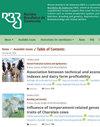Influence of irrigation and supplementation on performance and ingestive behavior of beef cattle on mixed grass pastures
IF 1.2
4区 农林科学
Q3 Agricultural and Biological Sciences
Revista Brasileira De Zootecnia-Brazilian Journal of Animal Science
Pub Date : 2023-08-11
DOI:10.37496/rbz5220220055
引用次数: 0
Abstract
- The purpose of this study was to evaluate the performance of beef cattle with two levels of energy-protein supplementation of low-consumption on African Bermudagrass pasture, overseeded in winter with oat and ryegrass, with or without irrigation. Twenty-four castrated Angus steers (11 months old and had an initial average of 220 kg body weight (BW)) were used in experimental area of 3.6 ha. The experiment was completely randomized in a 2×2 factorial design, with three replicates. The evaluation period was 249 days (July/2019 to March/2020). The treatments were: irrigated pasture with supplementation of 1 g/kg BW or 2.7 g/kg BW and non-irrigated pasture with 1 g/kg BW of supplement or 2.7 g/kg BW. The grazing method was continuous with a variable stocking rate. Irrigation provided pastures with better chemical composition in winter and spring. Irrigation increased the daily accumulation rate in winter (84.6 vs. 45.9 kg DM/ha/day), providing a greater stocking rate (1,702 vs. 1,385 kg/ha) and, consequently, body weight gain per hectare. Supplementation of 2.7 g/kg BW provided a greater stocking rate in winter (1,652 vs. 1,435 kg/ha) and spring (3,096 vs. 2,811 kg/ha), not changing in summer. The association of irrigation and supplementation of 2.7 vs. 1.0 g/kg BW improves the intake pattern by the animal in summer without changing productivity parameters. Irrigation increases productivity and the nutritional value of pasture with higher livestock production per area in periods of water deficit. The supply of 2.7 vs. 1.0 g/kg BW provides a greater stocking rate and body灌补对混交草牧场肉牛生产性能和摄食行为的影响
-这项研究的目的是评价在非洲百慕大草牧场上补充两种低消耗的能量蛋白水平的肉牛的生产性能,在冬季过量播种燕麦和黑麦草,有或没有灌溉。选用24头11月龄、初始平均体重220 kg的阉割安格斯阉牛,试验面积为3.6 ha。实验采用2×2因子设计,完全随机化,有3个重复。评估期249天(2019年7月至2020年3月)。分别饲喂1 g/kg BW或2.7 g/kg BW的灌水草地和饲喂1 g/kg BW或2.7 g/kg BW的非灌水草地。放牧方式为连续放牧,载畜率变化。灌溉在冬季和春季提供了更好的化学成分。灌溉提高了冬季日积累率(84.6比45.9 kg DM/ha/day),提供了更高的放养率(1702比1385 kg/ha),因此,每公顷体重增加。添加2.7 g/kg体重在冬季(1,652对1,435 kg/ha)和春季(3,096对2,811 kg/ha)提供了更高的载畜率,在夏季没有变化。2.7 g/kg BW与1.0 g/kg BW灌溉和补充的结合改善了夏季动物的摄食模式,而不改变生产力参数。在缺水时期,灌溉提高了牧草的生产力和营养价值,提高了单位面积的牲畜产量。2.7 g/kg体重比1.0 g/kg体重提供了更高的放养率和体
本文章由计算机程序翻译,如有差异,请以英文原文为准。
求助全文
约1分钟内获得全文
求助全文
来源期刊
CiteScore
1.90
自引率
0.00%
发文量
25
审稿时长
8 weeks
期刊介绍:
The Revista Brasileira de Zootecnia (RBZ; Brazilian Journal of Animal Science) encompasses all fields of Animal Science Research. The RBZ publishes original scientific articles in the areas of Aquaculture, Biometeorology and Animal Welfare, Forage Crops and Grasslands, Animal and Forage Plants Breeding and Genetics, Animal Reproduction, Ruminant and Non-Ruminant Nutrition, and Animal Production Systems and Agribusiness.

 求助内容:
求助内容: 应助结果提醒方式:
应助结果提醒方式:


